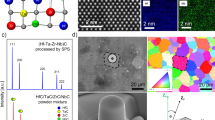Abstract
Shock-recovery and shock-spallation experiments were performed on two compositions of aluminium-infiltrated B4C cermets as a function of shock pressure. Sixty-five per cent volume B4C-Al cermets were recovered largely intact after shock loading up to pressures of ca. 12 GPa which permitted a critical study of the microstructural changes produced by the shock. Significantly, shock loading to between 12 and 13 GPa produced a combination of dislocation debris, stacking faults and deformation twins in a small fraction of the B4C grains. Fragmentation of shock-loaded 80% B4C-Al samples prevented meaningful microstructural investigation. Spall-strength testing also provided indirect evidence for the Hugoniot elastic limits (HEL) of these composites. Spall-strength calculations based on an elastic equation of state for 65% B4C-Al indicated that the elastic regime extended up to shock pressures of ca. 10 GPa, or approximately 65% of the HEL of polycrystalline B4C. A complete loss of spall strength was then observed at the transition to a plastic equation of state at a pressure of 12 GPa which coincided with observations of plasticity within the B4C-substructure. This study demonstrated that composites containing a highly ductile phase combined with a high compressive strength ceramic phase could support high dynamic tensile stresses by resisting the propagation of catastrophic cracks through the brittle ceramic substructure.
Similar content being viewed by others
References
D. E. Grady and M. E. Kipp, Int. J. Rock. Mech. Min. Sci. Geomech. Abstr. 16 (1979) 293.
M. E. Kipp and D. E. Grady, “Shock compression and release in high-strength ceramics” (Sandia National Laboratory, SAND89-1461, UC-704, July 1989).
G. T. Gray III, “Shock-wave and high strain-rate phenomena in materials”, edited by M. Meyers, L. Murr and K. Staudhammer (Mercel Dekker, New York, 1992) p. 899.
Y. Syono, T. Goto, Y. Nakagawa and M. Kitamura, in “High pressure research”, edited by M. H. Manghnani and S. Akimoto (Academic Press, New York, 1977) p. 477.
D. E. Grady, ibid.in “ p. 389.
R. Jealoz, J. Geophysical Res. 85 (1980) 3163.
J. A. Brusso, D. E. Mikkola, J. E. Flinn and P. V. Kelsey, Scripta Metall. 22 (1988) 47.
D. M. Vanderwalker and W. J. Croft, J. Mater. Res. 3 (1988) 761.
L. Lourdo, A. Lindfors and M. Meyers, Dymat88 J. De Physique Colloque C3 Supplement # 9 49 (1988) 133.
D. Millius, Private communication (1989).
T. P. Liddiard Jr, in “Fourth symposium on detonation”, edited by USNOL (US Government Printing Office, Washington, DC 1965) p. 214.
L. M. Barker and R. E. Hollenbach, J. Appl. Phys. 41 (1970) 4208.
V. I. Romanchenko and G. V. Stepanov, Zhur. Prik. Mekh. Tekh. Fia. 4 (1980) 141.
G. T. Gray III, P. S. Follansbee and C. E. Frantz, Mater. Sci. Engng. A111 (1989) 9.
E. P. Papadakis, in “Physical acoustics principles and methods”, Vol. 12, edited by W. P. Mason and R. N. Thurston (Academic Press, New York, 1976) Ch. 5.
G. T. Gray III and J. C. Huang, Mater. Sci. Engng. A1415 (1991) 21.
G. H. Kim, M. Sarikaya, D. L. Millius and A. K. Aksay, in “Proceedings of the 47th Annual Meeting of the Electron Microscopy Society of America”, edited by G. W. Bailey (San Francisco Press, CA, 1989) p. 562.
W. Voigt, in “Lehrbuch der kristallphysik” (Teubner, Leipzig, Germany, 1928) p. 739.
A. Reuss, Z. Angew. Math. Mech. 9 (1929) 49.
R. Hill, Proc. Phys. Soc London A65 (1952) 349.
W. R. Blumenthal, Unpublished work.
P. S. Follansbee, in “Shock compression of condensed matter — 1989”, edited by S. Schmidt, J. N. Johnson and L. Davidson (Elsevier, New York, 1990) p. 349.
Author information
Authors and Affiliations
Rights and permissions
About this article
Cite this article
Blumenthal, W.R., Gray, G.T. & Claytor, T.N. Response of aluminium-infiltrated boron carbide cermets to shock wave loading. Journal of Materials Science 29, 4567–4576 (1994). https://doi.org/10.1007/BF00376280
Received:
Accepted:
Published:
Issue Date:
DOI: https://doi.org/10.1007/BF00376280




